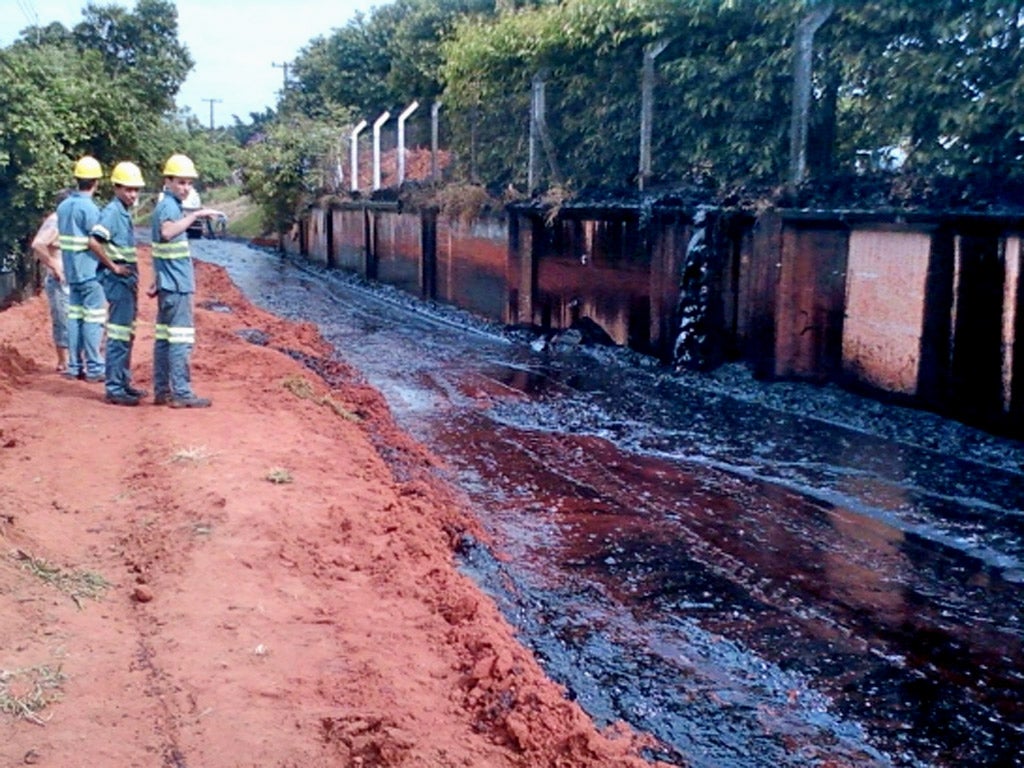Recipe for disaster: take 30,000 tons of sugar, turn up heat, and stand well back
Following a fire at a warehouse, a flood of molten caramel threatens a Brazilian town

Your support helps us to tell the story
From reproductive rights to climate change to Big Tech, The Independent is on the ground when the story is developing. Whether it's investigating the financials of Elon Musk's pro-Trump PAC or producing our latest documentary, 'The A Word', which shines a light on the American women fighting for reproductive rights, we know how important it is to parse out the facts from the messaging.
At such a critical moment in US history, we need reporters on the ground. Your donation allows us to keep sending journalists to speak to both sides of the story.
The Independent is trusted by Americans across the entire political spectrum. And unlike many other quality news outlets, we choose not to lock Americans out of our reporting and analysis with paywalls. We believe quality journalism should be available to everyone, paid for by those who can afford it.
Your support makes all the difference.A thick river of treacle is threatening to swamp a town in Sao Paulo state in southern Brazil, after a fire in a warehouse melted more than 30,000 tons of sugar. The blaze comes just days after a large fire in the port of Santos, also in the state, destroyed six warehouses leased by Copersucar, the largest exporter of sugar and ethanol in Brazil.
The fire, which erupted on Friday, began after a spark from machinery powering a loading belt ignited sugar stored in the depot owned by Agrovia Sugar Company.
Firefighters tackling the blaze on the industrial site in Santa Adelia, struggled for more than 75 hours to bring the flames under control. As the fire swept through the building, melted molasses poured out onto the streets and towards people’s homes. Nearly 20 residents were moved out into hotels as four were reported to have been injured.
“The fire consumed the entire warehouse, and firefighting teams worked to isolate a second depot by cooling the walls,” said Guilherme Raposo, chief executive of Agrovia.
Recent reports indicate the blaze is now under control but there are still fears the strength of the melted sugar and high temperatures could bring down the warehouse.
Barriers of earth were piled in front of houses to try to prevent the syrupy liquid from engulfing them. Emergency services are still battling against a steady tide of heavy caramel after four days and large suctioning machinery is being used to siphon up the thick liquid. Tractors and JCB diggers are scooping up the sugary substance, a ditch has been dug around the affected area to channel the flow and barriers have been installed in an attempt to reduce contamination to the local river.
“I am really worried about my home being invaded with this mess,” said Augusto Costa, a local builder. “The liquid is already around my house and I don’t know how bad it’s going to get.”
According to Jose Ferreira de Andrade, an engineer from the Environmental, Sanitation and Technology Company for Sao Paulo (CETESB) the flood of treacle has already polluted the nearby river Sao Domingos killing fish.
“Yesterday, oxygen levels in the water were zero,” said Mr Andrade. “The product is not toxic, but because of its density it depletes the oxygen. So far we have already collected over 15kg of dead fish,” he added.
“The sugar did not belong to Agrovia, but it is still our responsibility,” Mr Raposa admitted. The loss of this volume of sugar represents approximately $130 million, according to market analysts.

The Agrovia plant, located 450km from the port of Santos, supplies 20 per cent of sugar to the state of Sao Paulo and exports 1.7 million tons worldwide. The blaze is likely to push up sugar prices again.
Following the fire in Santos that destroyed 180,000 tons of sugar on 18 October, sugar prices rose by 2.63 per cent. Brazil is the largest producer in the world. This year through to September, Brazil exported 13 million tons of sugar, earning $5.9billion.
Join our commenting forum
Join thought-provoking conversations, follow other Independent readers and see their replies
Comments